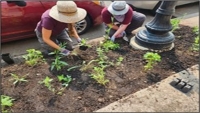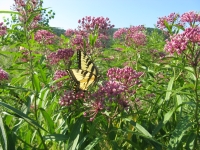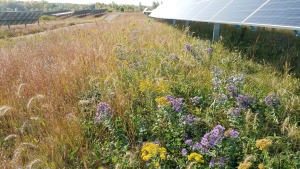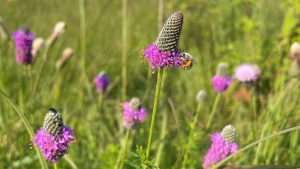BWSR Winter 2025 Ecology Update

Ecology and Landscape Resiliency programs and initiatives play a key role in furthering the Minnesota Board of Water and Soil Resources’ (BWSR) mission to work with partners to improve and protect Minnesota’s land and water resources. Healthy biological systems and biodiversity play a key role in improving water quality, sequestering carbon and making landscapes more resilient. Now is a critical time for protecting many plants and animal species with declining populations such as the monarch butterfly, the rusty patched bumblebee and many songbirds. The following update provides information and next steps related to BWSR’s ecology and resiliency efforts focused on pollinator conservation, biodiversity, climate adaptation and mitigation, ecological health and equity.
Living Landscapes Initiative
BWSR’s Living Landscapes Initiative focuses on addressing the environmental challenges of climate change and biodiversity loss through collaboration with conservation partners, communities and Minnesota residents. The initiative aims to increase awareness about declining wildlife and plant populations, exploring solutions to these challenges, and engaging diverse communities across Minnesota to collaborate on conservation efforts.
Key goals include:
- Support more than 20,000 projects through funding and technical assistance by 2030
- Build a movement to support declining plant and wildlife species
- Explore innovative approaches to restore habitat and increase landscape resiliency
- Support sustainable food systems
- Support conservation partners by providing funding, outreach and technical resources
Lawns to Legumes (L2L)
The Lawns to Legumes Program supports a movement to protect pollinator populations and other wildlife through community-based conservation, funding for residents and local conservation organizations, and outreach. Projects establish pollinator habitat in residential settings (such as yards) and community spaces, offering residents the opportunity to take a hands-on approach to conservation. The program has supported around 10,000 plantings.

In addition to funded projects, the program offers support to gardeners who take a DIY approach. Lawns to Legumes yard signs are being mailed to residents who map their DIY projects on the program’s webpage. BWSR staff will also be piloting an effort to work with SWCDs and other organizations to distribute yard signs, and seed packets to residents and schools as part of plant sales, and outreach efforts. Please contact BWSR Senior Ecologist/Vegetation Specialist Dan Shaw at dan.shaw@state.mn.us if you are interested in collaborating on this opportunity.
- L2L Individual Support Funding: Any Minnesota resident with an area for outdoor planting can apply for a $400 individual support grant and coaching assistance to install a pollinator habitat project. The application period for fall 2025 projects will open in February. Please visit the coaching webpage if you are interested in guiding residents on their journey to protect pollinators.
- L2L Pollinator Pathways: Pollinator Pathways Grants
New Pollinator Pathways projects were funded in the fall of 2024 for local organizations to lead plantings in a combination of residential landscapes and community spaces to build pollinator corridors, raise awareness about residential pollinator protection and showcase best practices. Organizations overseeing a Pollinator Pathways grant work with local residents and partners to install new pollinator habitat in residential and community spaces. During the last five years, over 40 projects have been funded in communities across Minnesota. Eligible applicants include Tribal Governments, soil and water conservation districts, watershed districts, counties, municipalities, non-government organizations and pre-k through grade 12 schools. Funding for a new application process will depend on the result of the upcoming legislative session.
For additional information, contact Erin Loeffler, BWSR ecological science conservationist, at erin.loeffler@state.mn.us.
Habitat Enhancement Landscape Program (HELP)

The Habitat Enhancement Landscape Program (HELP) prioritizes landscape and regional scale initiatives that restore and enhance strategically located, diverse native habitat across Minnesota on conservation lands and natural areas to benefit populations of bees, butterflies, dragonflies, birds and other wildlife. Projects are located on lands with a long-term commitment to conservation management. Example projects include those with existing easements, nonprofit conservation preserves, city parks, county parks and protected natural areas. Over 30 projects have been funded in past rounds; and funding for a new application period will depend on the upcoming legislative session. Due to the high need for habitat enhancement across Minnesota, BWSR will be looking for additional funding sources and opportunities to partner with a wide range of organizations.
Habitat Friendly Utilities Program
The Habitat Friendly Utilities Program has a goal of shifting management practices on utility projects to decrease the risk of invasive species and maximize benefits for a wide range of wildlife species. The program is also working to build partnerships between utility companies and the conservation community, and promote new innovative management approaches through testing strategies on pilot projects and making new technical resources available. Please contact Dan Shaw at dan.shaw@state.mn.us for more information about the program.

Habitat Friendly Solar Program
Started in 2016 through state legislation, BWSR’s Habitat Friendly Solar Program encourages the establishment of diverse native vegetation as part of solar projects. These projects offer landscape co-benefits such as carbon sequestration, water management, pollinator habitat, bird habitat, conservation grazing and improved
landscape aesthetics. There are approximately 70 projects that meet this state standard covering around 7,000 acres and sequestering around 11,000 metric tons of carbon a year and capturing around 16,000-acre feet of water. A key focus of this program is to build collaboration between the solar industry and conservation partners. A new resource is available on the program’s webpage to guide the yearly maintenance of solar projects. Please contact Dan Shaw at dan.shaw@state.mn.us with any questions about this program.
Habitat Friendly Roadsides
As part of efforts to establish habitat across a wide range of landscapes to support wildlife species and increase resiliency, BWSR will be increasing guidance and outreach on roadside habitat. A Minnesota Erosion Control Association (MECA) right-of-way workshop will be held on April 2 covering topics related to Monarch CCAAs, soil management, vegetation establishment and management.
CRP Incentives
The federal Conservation Reserve Program (CRP) State Incentives Program plays in important role in water management and providing habitat across agricultural landscapes. The BWSR CRP State Incentives Program provides grants to eligible watershed plan partnerships to incentivize landowner enrollment or re-enrollment into the federal Continuous Conservation Reserve Program (CCRP). These CCRP practices improve or protect surface water or groundwater pollution, drinking water, soil health, pollinator and wildlife habitat, and other conservation enhancements. Details about this program are found on the CRP State Incentives Program webpage. Jason Beckler, BWSR ecological science conservationist, can provide additional details at jason.beckler@state.mn.us.
Climate Change
Agencies are working to update the Minnesota Climate Action Framework with a focus on climate action steps identified in the plan to further refine steps that are needed for climate adaptation and mitigation in Minnesota. BWSR programs related to peatland restoration, soil health, conservation easements, water storage, and landscape resiliency are working to accomplish actions identified in the Climate Action Framework.
BWSR recently updated the Climate Resiliency Toolbox with a new section developed on residential landscapes that will continue to evolve. The toolbox will go through additional updates, and we are interested in input about the tool from conservation partners. Please submit input to dan.shaw@state.mn.us.

Cooperative Weed Management Areas
With climate change, we are facing increasing pressure from invasive species. Cooperative Weed Management Areas are partnerships that collaborate on invasive species control across geographic areas. The BWSR program started in 2008 and efforts in Minnesota have occurred in 49 counties.
Developing Recommendations for Native Vegetation
2023 Legislation directed BWSR to work with a wide range of partners to increase collaboration about the use of native vegetation and establishing biodiversity across landscapes. Key discussion topics have included appropriate seed and plant source distances for projects, climate considerations for vegetation, appropriate plant species for programs, and the status of state resources about vegetation establishment, enhancement and management. The discussions are being used to develop guiding principles and recommendations that will aid the continued evolution of BWSR’s Native Vegetation Establishment and Enhancement Guidelines and other state technical resources that are used for many programs. If you are interested in being part of these discussions, please contact Dan Shaw at dan.shaw@state.mn.us.
BWSR Easements
BWSR easement programs play an important role in protecting a wide range of landscapes in Minnesota. For more details about Reinvest in Minnesota (RIM) programs see the RIM Rundown.

In 2023, BWSR received $4 million from the General Fund for the purpose of enhancing existing RIM easements. Enhancements are for the purpose of climate resiliency, adaptation, and carbon sequestration and include but are not limited to increasing biodiversity and mitigating the effects of rainfall and runoff events. These funds will be divided evenly between wetland and vegetation enhancements. This funding is linked to Minnesota’s Climate Action Framework.
Enhancement funds will prioritize projects where the landowner is willing to purchase a custom seed mix(es), did not receive any portion of the original easement payment, and are willing to provide an elected cost match (cash or in-kind).
Projects best suited for enhancement will be on sites that are surrounded by existing habitat, were enrolled prior to 2014, have low diversity, and/or are threatened with noxious weed pressure.
Applications will be reviewed at the end of every month. Funding is available until spent or June 30, 2029, whichever comes first.
Forested and Woodland Native Plant Communities
Forested landscapes in Minnesota once covered 31.6 million acres or almost 60% of the state. Today, forest lands cover 17.4 million acres or 32%. Private landowners own approximately 6.8 million acres, or 40% of forest lands. The Minnesota Department of Natural Resources (DNR) Forest Stewardship Program helps woodland owners manage their woods through advice and education, woodland stewardship plans, cost share, and land protection programs. BWSR has partnered with the DNR for the past 40 years to support the delivery of forestry services with the state’s soil and water conservation districts and consulting foresters with a focus on a watershed basis at landscape scales.
The DNR’s Division of Forestry has developed a broad array of resources for forested and woodland native plant communities which complement the BWSR Native Vegetation Establishment and Enhancement Guidelines. The NPC silviculture strategies for forest stand prescriptions inform sustainable forest management in Minnesota.
DNR recently received two federal grants in partnership with BWSR, Tribal and local conservation partners. These grants totaling $6.4 million dollars will help expand efforts to protect and restore forest lands where forest stewardship planning has been completed.
New and Updated Tools:
- Drained peatlands are a significant source of carbon emissions in Minnesota. To help identify restoration opportunities, BWSR has been developing a Potentially Restorable Peatlands Mapping Tool in partnership with other agencies and The Nature Conservancy. Contact Suzanne Rhees, BWSR Special Projects Coordinator, for more information: suzanne.rhees@state.mn.us
- The Blue Thumb Plant Finder has been updated through a collaborative effort. A webinar presented by John Bly, Director of Operations and Special Projects at Metro Bloom, and Dan Shaw provides an overview of the tool and green infrastructure topics: https://www.youtube.com/watch?v=hYhH14tlaO0
- New Featured Plant articles continue to be developed each month to highlight plant species that are important for conservation efforts. You can subscribe to Featured Plant here. We are looking for guest authors for Featured Plant articles. If you are interested in contributing, please contact Erin Loeffler at erin.loeffler@state.mn.us.
- BWSR is looking for new information and images from professionals about practices that have been successful to include in the What's Working for Conservation webpage. If you have new information to add, please contact Dan Shaw at dan.shaw@state.mn.us. New categories have recently been added to the webpage for solar and utility projects, climate adaptation and mitigation, and community-based projects.
BWSR staff have continued updating state seed mixes and developing fact sheets to guide their use. A table has been updated summarizing seed mixes that are on the BWSR website. New mixes are currently in development for lakeshores and forested landscapes. Fact sheets to guide installation and management are also in development for the following state seed mixes: Stormwater South and East, Stormwater Northeast, Dry Ponds/Swales, Native Grass Waterways, Compacted Trails, Silvopasture, Conservation Grazing South and West, Dry Short Urban Buffer, Eroding Bank Stabilization South and East, Mesic Short Urban Buffer, Shallow Rooted BMP, Sand Mine Reclamation, Forest Groundcover East, Oats Cover Crop, Winter Wheat Cover Crop, Soil Building Cover Crop
